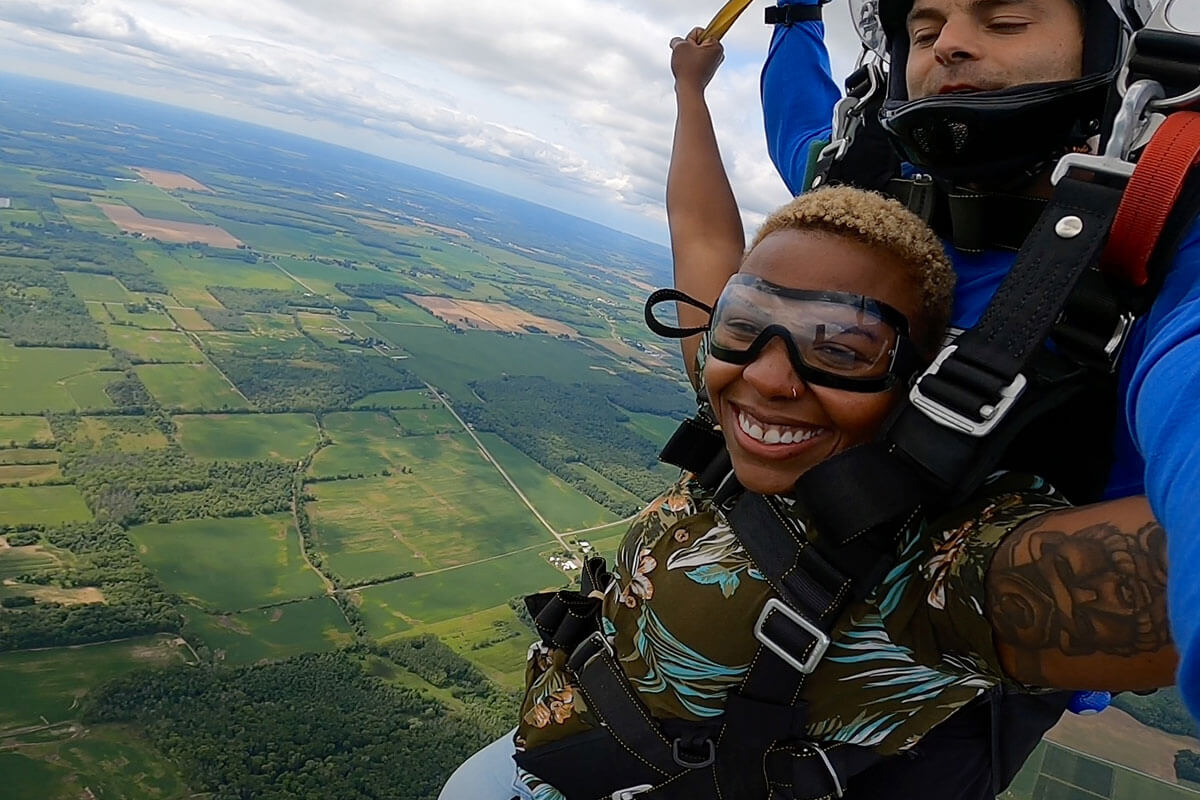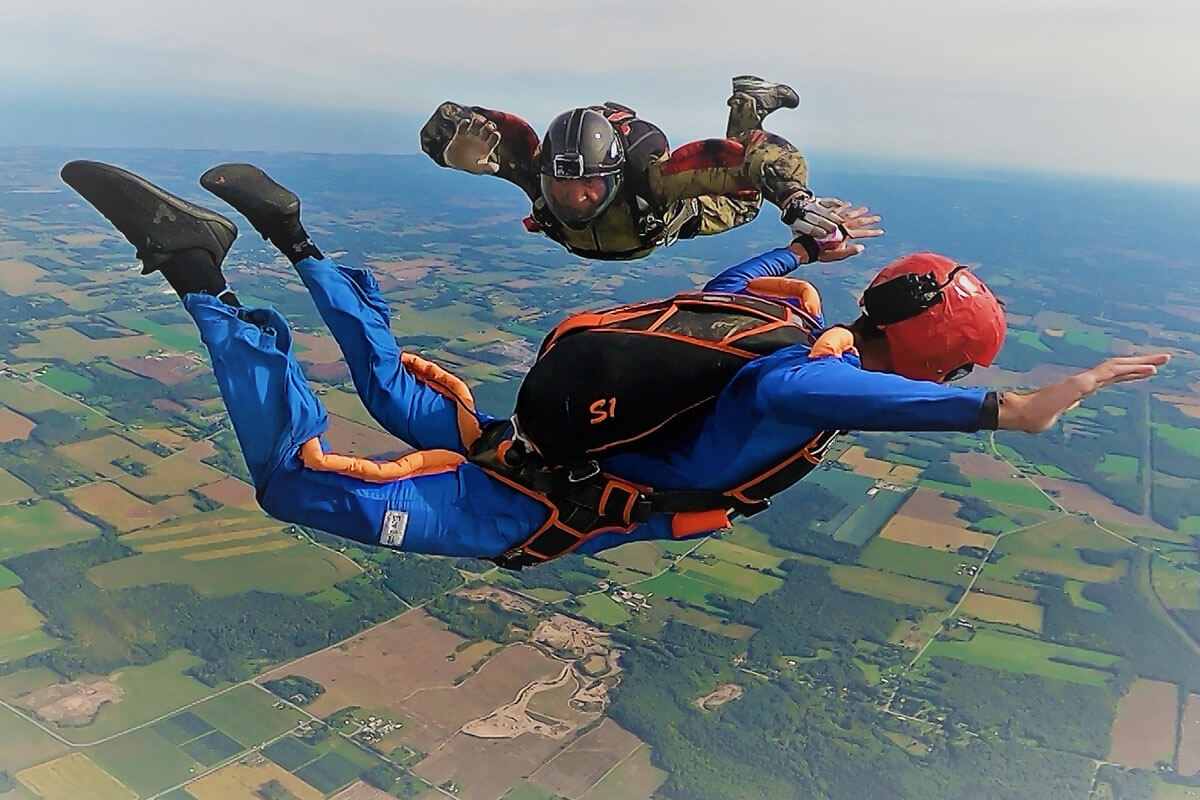If you’ve seen the old-school videos of the military landing round parachutes crashing into the ground, you may have the wrong impression of a typical parachute landing. Ouch!
Parachute technology has come a long, long way. For starters, the skydiver has much more control with the square parachute of today as opposed to the round parachute of yesteryear. With a square parachute, the skydiver is able to speed up, slow down, turn, stall, surge, spiral, and flare the parachute to control how the parachute flies and lands making for a buttery smooth landing, or a super cool swooping landing. Let us clear the air on all things parachute landing from the first-time tandem skydiver to the experienced jumper.

How Hard Is The Landing When Skydiving?
Is the landing hard in skydiving? The only thing hard about landing when skydiving is accepting that it’s over (sad face). All jokes aside, most skydiving landings are gentle thanks to the major upgrade(s) from modern parachute technology!
How fast are you going when you land from skydiving? The blossoming parachute above you is capable of slowing you down from 120 mph in freefall to a 15 mph or so as you float down. The skydiving ‘flare’ allows skydivers to adjust their vertical speed significantly, even with the ability to reach 0 mph if even for a second. If all goes according to plan, skydivers will usually touch down on their feet or slide in on their bottom – no problemo!
How Are You Supposed to Land When Skydiving?
The parachute landing begins at deploying the parachute at the appropriate height in order to initiate the parachute landing pattern. The last 15 seconds of descent are the most crucial for a successful parachute landing. Skydivers will note the wind direction, wind speed, and are responsible for following the landing pattern direction depending on the dropzone.
Skydivers are taught to land into the wind, if possible, in order to help slow down the horizontal forward momentum. Landing a parachute in the direction that the wind is blowing might get you going too fast, making it harder for a gentle landing. Comin’ in hot! Then the skydiver will pull the two toggles in unison to manipulate the position of the back of the canopy, slowing down the parachute. This parachute technique, along with landing into the wind, will slow a jumper down for an ideal parachute landing. Every parachute landing will be different depending on several factors; the main one being the type of skydiver you are.
Let’s look at the different parachute landings pertaining tandem skydivers, student skydivers, and sport skydivers.
Tandem Skydiving Landing
Listen to your instructor. If you are a tandem student, the instructor will guide you through every step of the parachute landing, so pay close attention to their instructions and follow their expert advice. The instructor will usually have you lift your legs to prepare for landing and will either have you slide in on your bottom or stand you up – this is at the instructor’s discretion ONLY. Don’t go trying to tell your instructor which way suits you best; they are operating with safety as the top priority.

Student Skydiving Landing
Parachute Landing Fall. When learning to land a parachute all on your own, the main focus is preventing injuries during landing. Therefore, student skydivers are taught the Parachute Landing Fall (PLF). The PLF landing technique is designed to minimize the impact on the joints in the case of an abnormal or hard parachute landing.
In a parachute landing fall, the student will press their feet and knees together, touch down on the balls of the feet and roll onto their side – almost like a parkour or ninja roll! This allows for the momentum to continue moving in order to distribute the force, rather than absorbing the force in your joints or back. The good thing is that PLFs are rarely needed, but it is important information to know in case you ever feel the need to perform a PLF due to high wind speeds, parachute malfunction, or when landing in an unfamiliar area.
Sport Skydiving Landing
Landing with style (and safety)! Once you get into sport skydiving, you’ll discover all of the different skydiving disciplines, including the world of neverending knowledge and skydive landing techniques. No really, there are even courses on this stuff!
Canopy courses are hosted at different dropzones all over the world in order to help fellow skydivers hone in on their skydive landing techniques or to even learn how to perform highly-skilled parachute landing maneuvers. One of those maneuvers is the “swooping” landing technique. In a swoop, a skydiver will manipulate the parachute to turn a certain degree of rotation in order to build speed, then use inputs on the rear risers or brake lines in order to change the pitch of the canopy. This causes the skydiver to glide across the ground at high speeds. Some of these swooping skydivers reach speeds upwards of 70 mph!
They even have competitions for this specific type of parachute landing. Currently, the world record for fastest canopy flight is held by Greg Windmiller, who covered a distance of 70 meters in 1.960 seconds – reaching a speed of roughly 95 mph! Wow! Flying a canopy in at high speeds significantly reduces the margin for error, which is why swooping should ONLY be attempted by highly experienced skydivers who have received proper training and canopy coaching.
What happens if you land in the water while skydiving? Licensed skydivers achieving their USPA B license will go through specific water training as an extra precaution on how to handle the situation when you accidentally land your parachute into the water.
Ready to experience a parachute landing for yourself? Book your jump or connect with us for more information on how to get started on your skydiving journey at WNY Skydiving. Blue skies!





